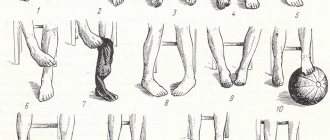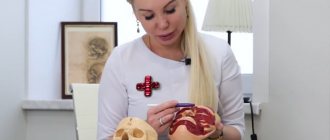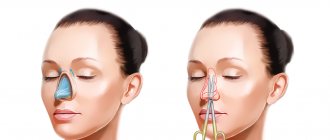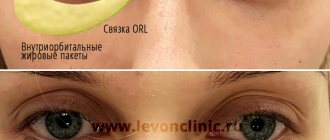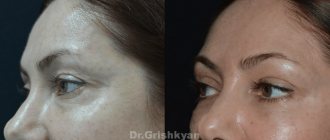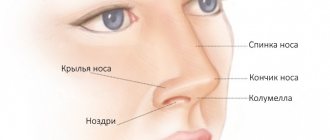Patients who want to undergo rhinoplasty spend a long time studying photographs of people who have already undergone the procedure on various resources on the Internet. In the vast majority of cases, they encounter photographs taken after the fact - either chiseled “Hollywood” noses, or outright mistakes of inexperienced or unknown plastic surgeons.
One way or another, minimal attention is paid to when discussing the operation and demonstrating the results . Therefore, the specifics and duration of resolution of nasal swelling after rhinoplasty often surprises, frightens or disappoints those who have not sufficiently studied the information aspect of nose correction surgery.
Rhinoplasty is one of the most difficult and traumatic operations in plastic surgery. During its implementation, various structures of the internal and external nose are damaged - bones, cartilage, mucous membranes, soft tissues and blood vessels.
Swelling after rhinoplasty is an absolutely natural and normal phenomenon that occurs in 100% of cases.
The presence and severity of edema does not depend on the type of correction - open or closed rhinoplasty.
How long does nasal swelling last after rhinoplasty?
The standard period for evaluating the final result of rhinoplasty is one year from the date of its completion.
There are a number of subjective factors that can affect its duration:
- The current age of the patient, which determines the rate of regeneration;
- Individual characteristics of the body (tendency to physiological and pathological edema, metabolic rate, fragility of blood vessels, etc.);
- The degree of density (thickness) and elasticity of the skin on the nose;
- Localization of medical manipulations during rhinoplasty (full rhinoplasty or rhinoplasty of the tip of the nose);
- Patient behavior during rehabilitation.
On average, complete resolution of swelling occurs 9-12 months after rhinoplasty.
What to do about loss of smell
Despite the fact that septoplasty does not involve dramatic changes in the functionality of the body, there are certain risks of complications. Such cases occur rarely, but such a possibility cannot be excluded.
Complications during the rehabilitation period include:
- constant bleeding;
- a feeling of numbness in the upper (front) teeth and tip of the nose;
- spread of infection;
- formation of a hole in the nasal septum;
- lack of positive results regarding health and cosmetic effect.
The occurrence of complications may be influenced by certain factors that are associated with the characteristics of the body or the patient’s lifestyle.
- poor blood clotting;
- severe heart pathologies;
- the presence of many scars after previous operations;
- groups of drugs;
- cocaine use and smoking.
Complications can usually be detected only one or two weeks after septoplasty. When detecting violations, it is necessary, first of all, to contact specialists to find out the cause of the deviations.
In the future, doctors, if possible, take measures to eliminate complications. You should not delay visiting your doctor or perform any actions on your own. This can lead to even bigger problems.
Swelling after rhinoplasty by month
Swelling after rhinoplasty can be primary and secondary (external and internal).
Primary edema
Primary edema appears during the procedure and disrupts full visualization of the surgical field. For this reason, competent plastic surgeons and anesthesiologists perform local administration of combinations of drugs that enhance the drainage of blood and lymph from the affected tissues. The same manipulation partially neutralizes the primary edema, facilitating the patient’s postoperative adaptation.
From the point of view of sensations, the most difficult thing for the patient is the primary edema. It is much more pronounced than the secondary one, therefore it brings a certain discomfort in the form of a feeling of fullness, pressure and obstruction in the nasal area. Fortunately, the primary swelling is well controlled by a splint (immobilizing bandage) and quickly disappears. After removing the splint, a temporary increase in primary edema is possible, which is neutralized after 1-2 days. Also, due to the retention of swelling by the splint, swelling of neighboring areas of the face is possible - the lower eyelids, cheeks, forehead, and even the chin.
The average duration of primary edema persistence is 7-10 days.
At this stage the patient should:
- Control your sleeping position - sleep only on your back with your head elevated (two pillows or a raised headboard);
- Avoid any physical activity, including housework;
- Limit postures with the head and face lowered forward (when washing, washing hair, etc.);
- Avoid face contact with water;
- Protect your face from sudden temperature changes and especially excessive overheating (sauna, bathhouse, etc.);
- Replace corrective glasses with contact lenses;
- Quit alcohol and cigarettes;
- Stop using skincare and decorative cosmetics.
An important note regarding smoking: nicotine provokes vasospasm, which further increases swelling and slows down regeneration in general. Of course, a plastic surgeon cannot control a patient’s bad habits. But if you want rehabilitation to be easier and faster, try to reduce the number of cigarettes you smoke, or even better, find an alternative in the form of an electronic cigarette with a nicotine-free mixture.
alcohol for the first 2-3 weeks of rehabilitation. In the future, drinking alcoholic beverages is possible, but it will provoke morning swelling of the face and nose throughout the entire recovery period.
During the first week after rhinoplasty, it is advisable to limit social activity to avoid potential injury or respiratory problems.
By 2-3 weeks after rhinoplasty, more than 60% of the primary swelling has disappeared. The face loses its puffy appearance; during this period, most patients resume social activity.
At this stage the patient should:
- Maintain control over the position of the body in sleep - it is no longer necessary to sleep on an elevation, but you still cannot turn on your side or stomach;
- Continue to abstain from strength training, running, heavy lifting and bending;
- Use caution when cleansing your face.
After removing the stitches and plaster
After consultation with the removal of stitches and plaster, consult your doctor about the use of medicinal ointments that stimulate tissue trophism (Traumel, etc.).
The unauthorized use of hot and cold compresses to relieve swelling is strictly prohibited! Such actions can lead to disastrous and painful consequences.
Closer to the second month after rhinoplasty, the primary swelling disappears completely. Only small swellings and induration may remain on the outside of the nose. It is important for the patient to continue to lead a healthy lifestyle, avoid physical inactivity and protect the nose from various injuries.
Secondary edema
Secondary edema is internal swelling that lasts up to a year. It can move, increase and decrease, change the shape of the nose, but it does not bring much discomfort to the patient. Guaranteed resolution of secondary edema occurs by 10-12 months after rhinoplasty, if no complications arise during rehabilitation.
Bandage
The plaster or thermoplastic bandage that the doctor will apply at the end of the operation can only be removed after 6-7 or even 14 days, depending on the complexity of the septoplasty. And all this time, the bones and cartilage must be tightly fixed to avoid displacement. Special devices - splints - are installed in the nasal cavity for 1-2 weeks. They help fix the tissues in the desired position and prevent the appearance of synechiae - adhesions. Although the bandage is unusual for the first time after surgery, it does not cause significant discomfort.
How long does swelling last after nasal tip rhinoplasty?
There is a noticeable difference between a full rhinoplasty and a tip rhinoplasty. In the first case, bone tissue is necessarily affected, in the second - only cartilage and skin. Due to less trauma, rehabilitation is faster, and swelling may subside by 6 months after surgery. As a rule, patients who have undergone tip rhinoplasty do not notice severe swelling on the face - rather, they are concerned about its hardness and enlargement.
If the plastic surgeon worked with outdated technology, in the early stages of rehabilitation, excessive upturning of the tip of the nose is possible, which then gradually drops. If rhinoplasty was carried out according to a modern scheme (structural rhinoplasty), a rigid supporting structure made of cartilage will not allow the tissues to move and deform, so the tip will remain in the same place, with an ideal nasolabial angle.
Structural rhinoplasty completely eliminates such delayed defects as upturning of the tip of the nose like a “piglet” or its drooping like an “eagle’s beak.”
Psychological help
In rare cases, patients require psychological assistance during the rehabilitation period after surgery.
This may be due to:
- severe painful sensations;
- presence of complications;
- or dissatisfaction with the result of septoplasty.
In a medical institution where such operations are carried out, there should be a psychologist who can help a person cope with stress.
The surgery undergone naturally affects a person’s emotional state. All experiences before septoplasty often provide an emotional outlet in the postoperative period.
The correct approach of a psychologist will help a person quickly recover and cope with all fears and worries.
A positive attitude during the rehabilitation period is very important for a full recovery.
And after septoplasty, psychological help is of particular importance, since due to breathing problems, many patients become depressed and violate the doctor’s instructions, which is dangerous for their health.
Read also: What is the bladder for?
Crusts
After septoplasty, the patient cannot perform sufficient nasal hygiene for some time.
You should not blow your nose too much, pick scabs, or even sneeze.
Therefore, the crusts and films that form on the healing wound surface also become the reason why the nose cannot breathe. At the same time, if the patient regularly visits the doctor, he will avoid this problem. During consultations, a specialist will clean the nasal cavity daily, treat it with softening and restorative medications, and perform a “nasal shower” to quickly restore function.
Synechia
After septoplasty, peculiar “bridges”, fusions between the walls of the nasal passages, may form in the nasal cavity. These strands block the lumen of the nasal cavity and interfere with the normal passage of air. As a result, the patient complains that he cannot breathe through his nose, he has a nasal sound, snores at night and experiences dry mouth. In addition to inconvenience for the patient, synechiae increases the risk of infectious complications after septoplasty.
Treatment for synechiae is only surgical. Under anesthesia or local anesthesia, the doctor will remove the cords using a scalpel or laser and install special splints (splints or silicone strips) that will prevent the appearance of synechiae in the future.
Septoplasty - surgical correction of the nasal septum
Septoplasty usually involves the most gentle surgical removal of the deviated parts of the nasal septum, previously detached from the covering mucosa and perichondrium or periosteum.
Deviated areas of the nasal septum that can be straightened are straightened in place and maintained.
Thus, by preserving our own tissues as much as possible, we ensure the preservation of the structure of the nasal septum, its strength and functionality. Incisions and sutures are made deep in the nasal cavity and are not visible from the outside.
Doctors providing this service
Types of dental anesthetics
Anesthesia means absence or loss of sensation. With light anesthesia, the person is conscious. In severe cases, the patient is put to sleep. The doctor at the Nika Dentistry clinic uses medications separately or in combination. Selects medications for a safe procedure. The type of anesthetic used also depends on the person's age, health, length of the procedure, and previous negative reactions to anesthetics.
Short-term medications are applied directly to the tooth area. Long-acting is used when complex jaw surgery is performed.
The success of dental anesthesia depends on:
- drug;
- areas of anesthesia administration;
- type of procedure;
- time of the operation;
- severity of inflammation.
Local anesthesia in the lower jaw is not as strong as in the upper jaw.
Doctors give three types of anesthesia: local, sedative and general. The choice depends on the location of the manipulation, the severity of the problem and the combination with other medications.
Local anesthesia
Local anesthesia is used for simple procedures such as tooth filling, which require a short time to complete and are less complex. The person is conscious and talking when local anesthesia is given. The area is numb so that the patient does not feel pain. A popular local anesthetic is lidocaine.
Local anesthetics will numb the pain within 10 minutes, and the best anesthesia for dental treatment wears off between 30 and 60 minutes. Sometimes a vasopressor such as epinephrine is added to enhance the effect and prevent the anesthetic effect from spreading to other parts of the body.
Local anesthetics are available in the form of gel, ointment, cream, spray, patch, liquid and ampoules. Use topically (apply directly to the area to numb it) or inject into the area being treated.
Sometimes sedatives are added to anesthetics to help you relax. The patient remains fully conscious and responds to commands after slight sedation. If the drug is moderate, the person is semi-conscious or almost unconscious if the sedation is deep.
Sedatives are administered orally (tablet or liquid), inhaler, intramuscularly, or intravenously. During moderate to deep sedation, the doctor monitors your heart rate, blood pressure, and breathing.
General anesthesia
General anesthesia is used for long procedures or when the client is nervous and interferes with treatment. The person is unconscious, does not feel pain, the muscles are relaxed, and does not remember how the operation took place. The medicine is administered by putting a mask on the face or intravenously. The dose depends on the procedure and the patient's condition.
What are the side effects
The side effects of dental anesthesia depend on the type of anesthetic used. General anesthesia has more risks than local anesthesia. Reactions also vary:
- nausea or vomiting;
- headache;
- sweating or shaking;
- hallucinations, delusions, or confusion;
- slurred speech;
- dry mouth or throat;
- pain at the injection site;
- dizziness;
- fatigue;
- numbness;
- trismus caused by trauma from surgery.
Vasoconstrictors such as epinephrine added to anesthetics also cause heart and blood pressure problems. These are some side effects of anesthetics. Ask your dentist about the medicine and any problems that may arise after use.
Precautions when prescribing
Pregnancy
Special Needs
Aged people
Liver, kidney, lung, or heart problems
Neurological diseases
Other conditions
Tell your dentist if you have a hiatal hernia, acid reflux, infections or open sores in your mouth, allergies, severe nausea and vomiting, or are taking medications that cause drowsiness.
The risks are higher for those who:
- sleep apnea;
- epilepsy;
- obesity;
- hypertension;
- heart problems;
- attention or behavior disorder;
- chronic obstructive pulmonary disease;
- gastric bypass;
- Substance abuse.
What are the risks of dental anesthesia
Most people do not experience adverse reactions with local anesthesia. There is a higher risk with general anesthesia, especially in older people and people with medical complications. There is an increased risk of abnormal bleeding while taking blood thinning medications such as aspirin. If you are taking painkillers or nerve medications, tell your dentist or surgeon so they can select an anesthetic.
Anesthesia risks:
- seizures;
- coma;
- respiratory arrest;
- heart failure;
- heart attack;
- stroke;
- hypotension;
- hyperthermia;
- muscle stiffness;
- breathing problems;
- tachycardia.
Allergic reaction
Tell your dentist about any allergies, including reactions to dyes or other substances: rash, itching, swelling of the tongue, lips, mouth, or throat, and difficulty breathing; The anesthetics articaine and prilocaine at a concentration of 4% damage nerves and cause paresthesia;
Perforation
Perforation of the nasal septum is one of the complications of septoplasty.
If your nose does not breathe or makes a whistling sound when breathing, you experience dryness in the nasopharynx, or, conversely, observe purulent discharge, you need to urgently consult a doctor.
Such symptoms may indicate a violation of the integrity of the nasal septum. Most often, this complication is associated with a malnutrition of the cartilage. If this condition is not treated, the nose will become deformed, become saddle-shaped, and breathing difficulties will only increase.
Treatment of perforations is surgical. The doctor will close the defect with a flap cut from adjacent tissues and carry out the necessary treatment of the damaged cartilage.
Anatomical defects
Various structural changes after septoplasty can cause nasal breathing problems. Such defects may be:
- Excessive narrowing of the bony vault
- Incomplete elimination of deviated nasal septum
- Excessive narrowing and deformation of nasal cartilage
- Weakness or excessive excision and narrowing of the nasal alae
In this case, the patient will experience not only difficulty breathing, but also headaches, dry throat, loss of smell and taste. In this case, the patient is indicated for secondary rhinoplasty to correct defects of the internal nasal valve.

